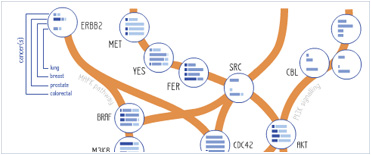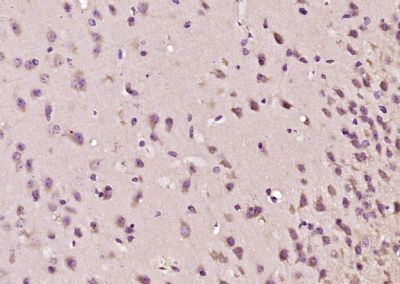JLP/MAX binding protein Polyclonal Antibody
Purified Rabbit Polyclonal Antibody (Pab)
- SPECIFICATION
- CITATIONS
- PROTOCOLS
- BACKGROUND

Application
| IHC-P, IHC-F, IF, ICC, E |
|---|---|
| Primary Accession | O60271 |
| Reactivity | Rat, Dog |
| Host | Rabbit |
| Clonality | Polyclonal |
| Calculated MW | 146 KDa |
| Physical State | Liquid |
| Immunogen | KLH conjugated synthetic peptide derived from human JLP/JIP-4 |
| Epitope Specificity | 101-188/1321 |
| Isotype | IgG |
| Purity | affinity purified by Protein A |
| Buffer | 0.01M TBS (pH7.4) with 1% BSA, 0.02% Proclin300 and 50% Glycerol. |
| SUBCELLULAR LOCATION | Cytoplasm. Cytoplasm, perinuclear region. Note: Perinuclear distribution in response to stress signals such as UV radiation. |
| SIMILARITY | Belongs to the JIP scaffold family. |
| SUBUNIT | Homooligomer. Interacts with MAX, MAPK8, MAPK9, MAPK10, MAPK14, MAP3K3, MYC, KNS2 and MAP2K4. Interaction with KNS2 is important in the formation of ternary complex with MAPK8. Interacts with NFKB1. |
| Post-translational modifications | Phosphorylated by MAPK8 and MAPK14 (By similarity). Phosphorylated upon DNA damage, probably by ATM or ATR. |
| Important Note | This product as supplied is intended for research use only, not for use in human, therapeutic or diagnostic applications. |
| Background Descriptions | JIP-4 is a 1,321 amino acid protein encoded by the human gene SPAG9. It contains a large N-terminal extracellular domain, a short transmembrane helical domain, and a cytoplasmic domain. There are 6 N-glycosylation sites, several phosphorylation sites for cAMP/cGMP-dependent protein kinase, protein kinase C, and casein kinase II, and 10 putative myristoylation sites. There is also a leucine zipper motif, with 6 leucine repeats, that may aid in dimerization since there is no upstream basic domain characteristic of DNA binding proteins. The JNK-interacting protein (JIP) group of scaffold proteins selectively mediates JNK signaling by aggregating specific components of the MAPK cascade to form a functional JNK signaling module. JIP-4 is a cytoplasmic, perinuclear protein that has eight known isoforms whose expression varies by tissue and disease state. |
| Gene ID | 9043 |
|---|---|
| Other Names | C-Jun-amino-terminal kinase-interacting protein 4, JIP-4, JNK-interacting protein 4, Cancer/testis antigen 89, CT89, Human lung cancer oncogene 6 protein, HLC-6, JNK-associated leucine-zipper protein, JLP, Mitogen-activated protein kinase 8-interacting protein 4, Proliferation-inducing protein 6, Protein highly expressed in testis, PHET, Sperm surface protein, Sperm-associated antigen 9, Sperm-specific protein, Sunday driver 1, SPAG9 (HGNC:14524) |
| Target/Specificity | Isoform 5 is expressed only in testis on the round spermatids of stage I, II and II. Isoform 5 is absent in spermatogonia and spermatocyte. Isoform 3 is expressed in testis. Isoform 4 is expressed in testis and in acute myeloid leukemia (AML) patients. |
| Dilution | IHC-P=1:100-500,IHC-F=1:100-500,ICC=1:100-500,IF=1:100-500,ELISA=1:5000-10000 |
| Format | 0.01M TBS(pH7.4), 0.09% (W/V) sodium azide and 50% Glyce |
| Storage | Store at -20 ℃ for one year. Avoid repeated freeze/thaw cycles. When reconstituted in sterile pH 7.4 0.01M PBS or diluent of antibody the antibody is stable for at least two weeks at 2-4 ℃. |
| Name | SPAG9 (HGNC:14524) |
|---|---|
| Function | The JNK-interacting protein (JIP) group of scaffold proteins selectively mediates JNK signaling by aggregating specific components of the MAPK cascade to form a functional JNK signaling module (PubMed:14743216). Regulates lysosomal positioning by acting as an adapter protein which links PIP4P1-positive lysosomes to the dynein- dynactin complex (PubMed:29146937). Assists PIKFYVE selective functionality in microtubule-based endosome-to-TGN trafficking (By similarity). |
| Cellular Location | Cytoplasm {ECO:0000250|UniProtKB:Q58A65}. Cytoplasm, perinuclear region {ECO:0000250|UniProtKB:Q58A65}. Lysosome membrane. Note=Perinuclear distribution in response to stress signals such as UV radiation {ECO:0000250|UniProtKB:Q58A65} |
| Tissue Location | Expressed only in testis on the round spermatids of stage I, II and II. Absent in spermatogonia and spermatocyte [Isoform 3]: Expressed in testis. |

Thousands of laboratories across the world have published research that depended on the performance of antibodies from Abcepta to advance their research. Check out links to articles that cite our products in major peer-reviewed journals, organized by research category.
info@abcepta.com, and receive a free "I Love Antibodies" mug.
Provided below are standard protocols that you may find useful for product applications.
If you have used an Abcepta product and would like to share how it has performed, please click on the "Submit Review" button and provide the requested information. Our staff will examine and post your review and contact you if needed.
If you have any additional inquiries please email technical services at tech@abcepta.com.













 Foundational characteristics of cancer include proliferation, angiogenesis, migration, evasion of apoptosis, and cellular immortality. Find key markers for these cellular processes and antibodies to detect them.
Foundational characteristics of cancer include proliferation, angiogenesis, migration, evasion of apoptosis, and cellular immortality. Find key markers for these cellular processes and antibodies to detect them. The SUMOplot™ Analysis Program predicts and scores sumoylation sites in your protein. SUMOylation is a post-translational modification involved in various cellular processes, such as nuclear-cytosolic transport, transcriptional regulation, apoptosis, protein stability, response to stress, and progression through the cell cycle.
The SUMOplot™ Analysis Program predicts and scores sumoylation sites in your protein. SUMOylation is a post-translational modification involved in various cellular processes, such as nuclear-cytosolic transport, transcriptional regulation, apoptosis, protein stability, response to stress, and progression through the cell cycle. The Autophagy Receptor Motif Plotter predicts and scores autophagy receptor binding sites in your protein. Identifying proteins connected to this pathway is critical to understanding the role of autophagy in physiological as well as pathological processes such as development, differentiation, neurodegenerative diseases, stress, infection, and cancer.
The Autophagy Receptor Motif Plotter predicts and scores autophagy receptor binding sites in your protein. Identifying proteins connected to this pathway is critical to understanding the role of autophagy in physiological as well as pathological processes such as development, differentiation, neurodegenerative diseases, stress, infection, and cancer.


